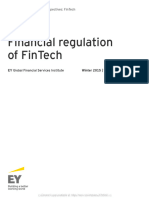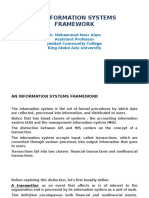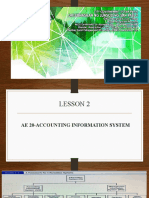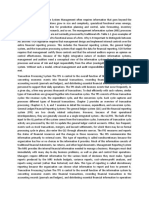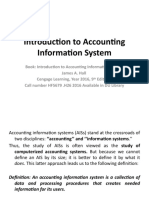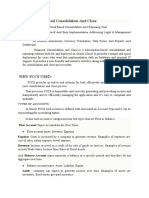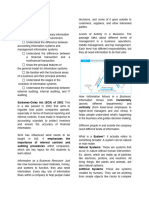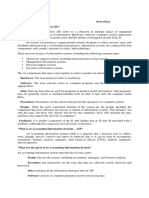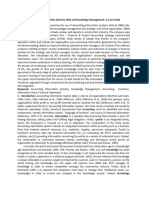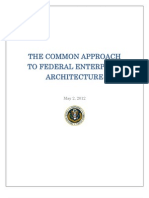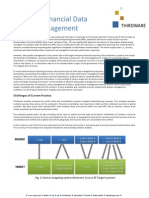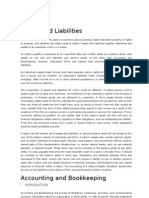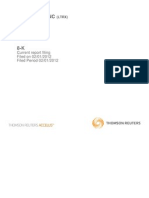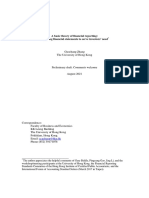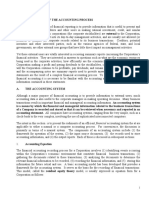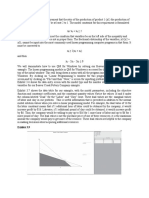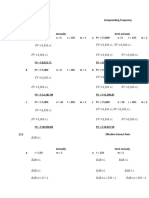Financial Reporting System: XBRL - Reengineering The Financial Report
Financial Reporting System: XBRL - Reengineering The Financial Report
Uploaded by
JPOriginal Description:
Original Title
Copyright
Available Formats
Share this document
Did you find this document useful?
Is this content inappropriate?
Report this DocumentCopyright:
Available Formats
Financial Reporting System: XBRL - Reengineering The Financial Report
Financial Reporting System: XBRL - Reengineering The Financial Report
Uploaded by
JPCopyright:
Available Formats
FINANCIAL REPORTING SYSTEM
The law dictates management’s responsibility for providing stewardship
information to external parties. This reporting obligation is met via the FRS. Much of the
information provided takes the form of standard financial statements, tax returns, and
documents required by regulatory agencies such as the Securities and Exchange
Commission (SEC).
The primary beneficiaries financial statement information are external users,
such as stockholders, creditors, and government agencies. Generally speaking, outside
users of information are interested in the performance of the organization as a whole.
Subsequently, they require information that allows them to observe trends in
performance over time and to make comparisons between different organizations.
Given the nature of these needs, financial reporting information must be prepared and
presented by all organizations in a manner that is generally accepted and understood
by external users
XBRL – Reengineering the Financial Report
Online reporting of financial data has become a competitive necessity for publicly
traded organizations. As of now, most associations achieve this by setting their financial
statements and other financial reports on their respective Web sites as Hyper Text
Markup Language1 (HTML) documents. These reports would then be able to be
downloaded by clients like the SEC, financial analysts, and other interested parties. The
HTML reports, however, cannot be conveniently processed through IT automation.
Performing any analysis on the data contained in the reports requires them to be
manually entered into the user’s information system.
Extensive Markup Language (XML)
XML is a metalanguage for describing markup languages. The term extensible
means that any markup language can be created using XML. This includes the creation
of markup languages capable of storing data in relational form in which tags are
mapped to data values. Thus, XML can be used to model the data structure of an
organization’s internal database.
You might also like
- Full Download Core Concepts of Accounting Information Systems 14th Edition Simkin Solutions ManualDocument36 pagesFull Download Core Concepts of Accounting Information Systems 14th Edition Simkin Solutions Manualhhagyalexik100% (35)
- Computer Solution of Goal Programming Problems With QM For Windows and ExcelDocument1 pageComputer Solution of Goal Programming Problems With QM For Windows and ExcelJPNo ratings yet
- Project Crashing With ExcelDocument1 pageProject Crashing With ExcelJP0% (1)
- 2 Debreceny XBRL Ratios 20101213Document31 pages2 Debreceny XBRL Ratios 20101213Ardi PrawiroNo ratings yet
- XBRL: Enabling Faster, More Transparent Financial ReportingDocument12 pagesXBRL: Enabling Faster, More Transparent Financial ReportingPrasad VeeraNo ratings yet
- Financial Regulation of FintechDocument17 pagesFinancial Regulation of Fintechsuperfeik2008No ratings yet
- A GENERAL MODEL FOR AIS Figure 1Document1 pageA GENERAL MODEL FOR AIS Figure 1Inday MiraNo ratings yet
- An Information Systems FrameworkDocument30 pagesAn Information Systems FrameworkDr. Mohammad Noor AlamNo ratings yet
- Lesson 2 - Ae20Document17 pagesLesson 2 - Ae20Krizza Ann Olivia NavarroNo ratings yet
- Processing SystemDocument2 pagesProcessing SystemInday MiraNo ratings yet
- AccountingDocument29 pagesAccountingMukeshChhawariNo ratings yet
- Assignment of AISDocument16 pagesAssignment of AISHaseeb WaheedNo ratings yet
- AIS Rep 1,2, 3Document6 pagesAIS Rep 1,2, 3Niia LeonesNo ratings yet
- HFM Implementation CASEDocument3 pagesHFM Implementation CASESam SamamNo ratings yet
- XBRL - A Global Fi Nancial Reporting Standard: ThemeDocument7 pagesXBRL - A Global Fi Nancial Reporting Standard: Themeksmuthupandian2098No ratings yet
- AIS Chapter 1Document31 pagesAIS Chapter 1Dr. Mohammad Noor AlamNo ratings yet
- The Philippine Government Information System PDFDocument27 pagesThe Philippine Government Information System PDFGiYan SalvadorNo ratings yet
- World Scope Datatype Definitions GuideDocument449 pagesWorld Scope Datatype Definitions GuideSunnyMahajanNo ratings yet
- The Financial Reporting System and XBRLDocument5 pagesThe Financial Reporting System and XBRLMikaerika AlcantaraNo ratings yet
- Financial Reporting andDocument58 pagesFinancial Reporting andJohn PaulNo ratings yet
- Transaciton ProcessDocument1 pageTransaciton ProcessRica de guzmanNo ratings yet
- C15. XBRL New ToolDocument20 pagesC15. XBRL New ToolHayderAlTamimiNo ratings yet
- Overview of Financial Consolidation and CloseDocument3 pagesOverview of Financial Consolidation and ClosenaniNo ratings yet
- Financial Reporting and Management Reporting SystemsDocument71 pagesFinancial Reporting and Management Reporting SystemscamsNo ratings yet
- Study On XBRL Implementation For Financial Reporting.Document41 pagesStudy On XBRL Implementation For Financial Reporting.sa281289100% (1)
- OECD Financial Management Information Systems in OECD CountriesDocument24 pagesOECD Financial Management Information Systems in OECD CountriesCristian Pablo Yáñez NavarroNo ratings yet
- Levels of Activity in A Business: TheDocument5 pagesLevels of Activity in A Business: TheitsyeoboNo ratings yet
- IFXDocument2 pagesIFXgeorgeholdridgeNo ratings yet
- What Is Information?Document6 pagesWhat Is Information?lezzzzhhhhaaabaybNo ratings yet
- Implications of The SarbanesDocument5 pagesImplications of The SarbanesArcha ShajiNo ratings yet
- DefinitionDocument2 pagesDefinitionKrisha TubogNo ratings yet
- Chapter One Accounting Principles and Professional PracticeDocument22 pagesChapter One Accounting Principles and Professional PracticeHussen Abdulkadir100% (1)
- XBRL in IndiaDocument23 pagesXBRL in Indiaksmuthupandian2098No ratings yet
- Accounting Information SystemsDocument5 pagesAccounting Information Systemsnominerdene.demNo ratings yet
- The Future of Accounting and Implications For Aspiring AccountantsDocument5 pagesThe Future of Accounting and Implications For Aspiring AccountantsIsaac Gabriel Kuruw100% (2)
- Management Information System: Submitted by Presented byDocument18 pagesManagement Information System: Submitted by Presented byrani222No ratings yet
- AC 2104 Chap 1 NotesDocument6 pagesAC 2104 Chap 1 NotessapilanfranceneNo ratings yet
- Financial AND Management Reporting SystemsDocument56 pagesFinancial AND Management Reporting SystemsEj BalbzNo ratings yet
- Management Accounting EssayDocument3 pagesManagement Accounting EssayUsman KhanNo ratings yet
- The Common Approach To Federal Enterprise ArchitectureDocument52 pagesThe Common Approach To Federal Enterprise ArchitectureFedScoopNo ratings yet
- Impact of Financial Data Quality Management: ThirdwareDocument2 pagesImpact of Financial Data Quality Management: ThirdwarePriyanka GargNo ratings yet
- What Is Financial ReportingDocument24 pagesWhat Is Financial ReportingIsha GajeshwarNo ratings yet
- Business Wire White Paper - XBRL Next Steps: What You Need To Know For 2010 and BeyondDocument9 pagesBusiness Wire White Paper - XBRL Next Steps: What You Need To Know For 2010 and BeyondIR Global RankingsNo ratings yet
- Financial Accounting N ReportingDocument11 pagesFinancial Accounting N ReportingPaulino marorNo ratings yet
- DefinitionDocument3 pagesDefinitionKathryn PuyatNo ratings yet
- Bookkeeping and Accounting CycleDocument9 pagesBookkeeping and Accounting CycleIhda Rachmatina Season IINo ratings yet
- For Companies To Obtain Additional Funding or CapitalDocument2 pagesFor Companies To Obtain Additional Funding or CapitalMoraine SantiagoNo ratings yet
- Solution Manual For Core Concepts of Accounting Information Systems 14th by SimkinDocument14 pagesSolution Manual For Core Concepts of Accounting Information Systems 14th by SimkinRuben Scott100% (40)
- Accounting Information Systems and The Accountant Discussion QuestionsDocument14 pagesAccounting Information Systems and The Accountant Discussion Questionscharisse vinz BucoyaNo ratings yet
- AIS Chapter OneDocument8 pagesAIS Chapter Onetarekegn gezahegn100% (1)
- Lantronix Inc: Current Report Filing Filed On 02/01/2012 Filed Period 02/01/2012Document29 pagesLantronix Inc: Current Report Filing Filed On 02/01/2012 Filed Period 02/01/2012shahrahulocNo ratings yet
- Chapter 1Document20 pagesChapter 1Stephanie De LeonNo ratings yet
- Quiz SIA - SolvedDocument5 pagesQuiz SIA - SolvedShinta AyuNo ratings yet
- Influential Factors of Country Accounting System DeveDocument12 pagesInfluential Factors of Country Accounting System DeveJoEst KaraNgNo ratings yet
- Exam 1-4 QuizletDocument16 pagesExam 1-4 QuizletkareemaNo ratings yet
- Analysis ProcessDocument9 pagesAnalysis ProcessDELOS SANTOS, APRIL JOY E.No ratings yet
- CG CHP 12 PDFDocument12 pagesCG CHP 12 PDFlani anggrainiNo ratings yet
- 1.8. A Basic Theory of Financial ReportingDocument28 pages1.8. A Basic Theory of Financial ReportingClaudia Urquijo RodríguezNo ratings yet
- Part Ii Review of The Accounting ProcessDocument26 pagesPart Ii Review of The Accounting Processአረጋዊ ሐይለማርያምNo ratings yet
- The Information SystemDocument10 pagesThe Information SystemABStract001No ratings yet
- Solution of Expected Value Problems With Excel and Excel QMDocument2 pagesSolution of Expected Value Problems With Excel and Excel QMJPNo ratings yet
- Exhibit 12.9: Nodes. The Square Is A Decision Node, and The Branches Emanating From A Decision Node Reflect TheDocument1 pageExhibit 12.9: Nodes. The Square Is A Decision Node, and The Branches Emanating From A Decision Node Reflect TheJPNo ratings yet
- Table 12.9 Payoff Table With Decisions, Given Perfect InformationDocument1 pageTable 12.9 Payoff Table With Decisions, Given Perfect InformationJPNo ratings yet
- Decision Trees With Excel and TreeplanDocument2 pagesDecision Trees With Excel and TreeplanJPNo ratings yet
- 2FDocument1 page2FJPNo ratings yet
- Exhibit 3.9Document1 pageExhibit 3.9JPNo ratings yet
- 3GDocument1 page3GJPNo ratings yet
- Scs 43Document2 pagesScs 43JPNo ratings yet
- 2xdxo (2 X 10,000 X 10 5: C No - of Order)Document1 page2xdxo (2 X 10,000 X 10 5: C No - of Order)JPNo ratings yet





